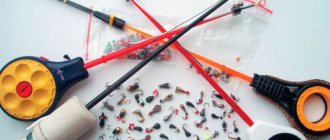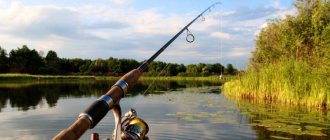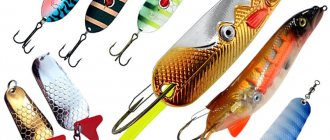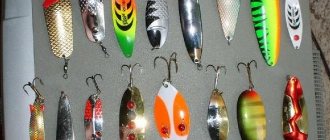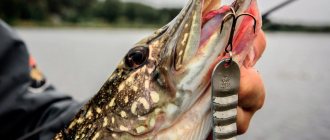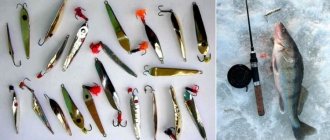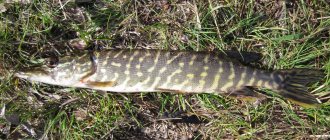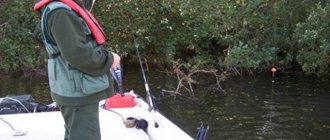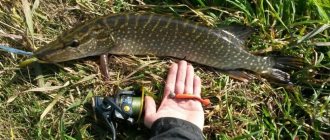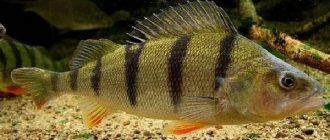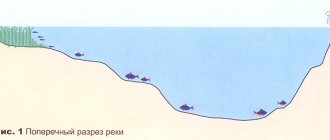The cherished trophy of every fisherman is a pike. But if many people know how to catch it in the summer, then there are few specialists in winter catching “toothy”. Fishing for pike from ice in winter is not the easiest thing to do. A catch awaits only those who have understood all the nuances, properly prepared the gear and identified a potentially catchy place. Choosing the time and taking into account weather conditions is also important.
Let's discuss all the components necessary for successful pike fishing in winter using a spoon. Everyone will find useful information for themselves - both beginners and experienced fishermen.
Specifics of pike trolling in winter
How does this fish behave when frost sets in? Why do its habits change on a body of water after it becomes covered with ice? Knowing the answers to these questions, it will be easier for you to understand where and how to catch pike with a spoon in winter.
- Firstly, this fish ceases to be as active as in the summer. If in open water it happily wanders throughout the entire water area in search of food, then on winter days it stays in the same places, cruises and feeds within a specific point. The predator practically does not make long swims. Attacks with quick and short bursts. The angler’s task is to understand where the pike is in order to place the bait as close to it as possible. Therefore, if there are no bites, do not sit in one place - move around the reservoir, drill more holes, fish for new points.
- Secondly, in winter the behavior and feeding activity of the “toothy” depends even more on weather conditions. The worse they are, the weaker the pike bite. In severe frosts, of course, she does not stop feeding, but she does this rarely and as if lazily. When it is cloudy and relatively warm (the thermometer is above -15 °C), this fish has a better appetite. Also, days that are more favorable for fishing are those on the eve of which there were no surges in atmospheric pressure that affect pike fishing in winter. Therefore, carefully study the barometer readings and the weather forecast before you go winter pike fishing with a spoon.
- Thirdly, the fish becomes very shy. Even perch and pike perch are much easier to catch in winter than pike. It happens that you drill a hole, and the toothy one, frightened, swims away from this place and does not return at all during the day. In the best case, it arrives after half an hour or an hour. Therefore, the fisherman should behave silently, do not make sudden movements, and drill holes immediately.
Tackle components
The spinning rod you used to catch pike in summer and autumn is not suitable for winter fishing. You will need specially mounted gear.
Rod
Some fishermen use homemade fishing rods. But making them is not easy, and store-bought options are much better. Therefore, we advise you to purchase special “sticks”. For example, carbon rods with cork handles have proven themselves well. There are also good fiberglass models. But carbon is preferable. Preferably with a titanium whip and guide rings with an SIC insert (allow you to fish with braided lines).
In terms of length, the optimal spinner is 35–40 cm. It is important that the rod is durable, not heavy and fits comfortably in the fisherman’s hand. Also choose “sticks” for vertical trolling. In another way, they are also called vertical fishing rods.
Coil
For the role of a reel for pike tackle, a medium-sized model with a diameter of about 10 cm is suitable. Capacity is up to 50 meters of fishing line. The ideal option is medium or even budget in the price segment. Be sure to be inertial with a high-quality reverse stopper and lever. Such characteristics of the reel will help when landing fish.
fishing line
An important element of any gear. When assembling a fishing rod for trolling pike, you should choose the “cord” responsibly and carefully. Basic requirements for it:
- Diameter. After all, we are going to fish with a spoon. These are heavy baits. And the pike itself resists solidly. In addition, there is always a chance that a specimen weighing 5–7 kg will bite. Therefore, the cross-section of the winter fishing line should be about 0.3 mm. Not less.
- Strength. This parameter is also important. When purchasing, check the tensile strength. The fishing line for pike tackle must be at least 7 kg.
- Rigidity. In this regard, braided line is better suited, but it often freezes, which prevents the bait from being cast correctly. Therefore, fishermen generally give preference to high-quality monofilament fishing line - elastic and with minimal stretch parameters.
We briefly described what fishing line should be like for winter trolling for pike from ice. On fishing forums you can find out a little more - read reviews on specific manufacturers and models.
Winter fishing rod equipment
All the components are ready, it’s worth thinking about equipping the fishing rod. It includes a nod and a leash. What are they for and is it possible to do without these elements? Let's figure it out.
Nod
This element is not used by everyone. Pike are often cast vertically. With this method, the nod does not help the angler improve his game, since pike lures are large and heavy. Allows you to see the bite? What for? If the fish grabs the bait, you will feel it perfectly with your hand. Therefore, whether to give a nod or not is your choice. An alternative is a simple tulip.
Leash
Be sure to install it if, as they say, you don’t want to be left with your nose. The pike has sharp and strong teeth, which can bite through ordinary fishing line with one movement. She also has a habit of grabbing her prey by the head. If your spinner is tied to a regular fishing line, then there is a high risk of losing both the catch and the bait.
What to use as leashes? There are several options:
- Leash made of string or steel (low price, but average characteristics in terms of visibility, flexibility and strength).
- Fluorocarbon with a diameter of 0.25-0.3 mm (best if your target is a medium-sized pike weighing about 1 kg).
- Kevlar (a modern material that is durable, soft and small in diameter).
- Titanium (we recommend using it with expensive baits, as it is very durable, but there is a drawback - it is often noticeable to fish).
Don't forget about the spinners! This is the most important element of the gear. The effectiveness of fishing largely depends on the arsenal of lures for pike in winter. We’ll talk about choosing spinners for pike fishing in winter in a similar way another time - we’ll dwell on how to choose them, which ones are best suited in color and shape, which options from which manufacturers are recommended by experienced sports fishermen, and much more. etc.
But from personal experience, we note that pike are more actively caught with spinners from ACME Kastmaster, Williams Wabler and Rapala.
The optimal leash length for trolling pike in winter is 20–30 cm.
Bottom wiring of a vertical spinner for pike
The technique of catching pike on the bottom line is simple and consists in the fact that a vertical pike spoon, due to its mass and hydrodynamic characteristics, guides itself along a certain trajectory. As a rule, pike bite during a pause after the lower vertical retrieve.
Indeed, everything is quite simple, not taking into account some nuances in the lower wiring of a vertical pike spoon, which some fishermen do not pay attention to, but are noticed by a far from stupid large experienced pike.
Considering that pike spoons gain energy for the bottom retrieve on the initial vertical vertical segment of the gliding path, primaks are called vertical.
And since most of my homemade spoons, designed for catching pike vertically, can then glide relatively far away from the release point, such vertical pike spoons are also called gliding.
But one way or another, given the fact that few fishermen even try to wait for the toothy predator to knock on the spoon during the pause after the top retrieve, the main one is considered to be the bottom retrieve of the vertical pike spoon.
Choosing a fishing spot
You will be able to find a point where pike hunt, and your chances of going home with your catch will increase dramatically. Therefore, choose your fishing spot carefully. Typically, in most reservoirs from December to March, the predator tries to feed:
- Near the snag;
- On changes (steps) of the bottom relief;
- Near slopes, holes and sudden changes in depth;
- At the border of underwater plants with areas of open water;
- Not far from rapids, confluences of other rivers or springs.
As you probably understand, pike choose for feeding in winter those points where it is inconspicuous and there are a lot of other fish, which become its food. Such places are promising for ice fishing with a spoon.
If you know the reservoir well and you often fish here in the summer, then there will be no problem finding a pike spot. It’s another matter if you come to fish on a new lake or river. An echo sounder can help, showing areas where fish feed. Or you can ask local fishermen - no one will reveal the most catchy places, but it’s quite possible to suggest a hole or two.
In winter, pike can be caught in areas with different depths. The fish feed both in shallow water and on decent dumps and holes. Where the food supply is larger, the “toothy” one usually hides there.
Time for ice fishing for pike using lures
Winter fishing with a lure for pike is possible during the entire period of “hard” water, that is, when lakes, rivers and ponds are covered with ice. However, at what time can it be more successful?
On the first ice, the pike does not bite as actively as in the fall, when it was really hungry. Nevertheless, the chances of catching a good specimen and not leaving with nothing are very good.
In early winter, pike still have the strength to move around the reservoir in search of food. And the oxygen content in water is high. Due to this, the predator diligently stores up nutrients. There is a high probability that your bait will not go unnoticed.
In December, winter trolling for pike is often best just after sunrise or an hour before sunset.
Closer to the dead winter and in January, the pike bite worsens. The oxygen balance in rivers and lakes becomes below normal, to which any fish reacts with less activity. Including the stern one.
In the middle of winter, it is difficult to identify time periods during the day when pike bite better. She can grab the bait in the morning, during the day, and at nightfall, when it becomes dark.
Closer to spring, this predatory fish again begins to eat more and more often. She moves more actively around the reservoir. All this increases the angler’s chances of catching it. Moreover, the best bite at the end of winter usually occurs during the daytime.
Choice of spinners
A spinner is an artificial bait that has a line attachment in the head and a hook in the tail. For pike, it is better to use spinners with a tee - a pike may not catch on a single hook, but it definitely won’t get off a triple hook. In appearance they resemble small fish.
The correct choice of bait for winter pike fishing is influenced by weather conditions, reservoir conditions and the size of the fish. In winter, you should select spinners designed for vertical fishing. Some general characteristics of pike lures can be identified:
1. They are made of various metals - brass, copper, cupronickel, as well as their combinations. A spinner, a combination of two metals, creates additional electromagnetic vibrations in the water that can better attract fish. Also, to increase weight, spinners are often soldered with lead. Metal lures have a significant advantage - pike teeth cannot damage them, and when tarnished, they can be easily polished and made attractive to fish again.
2. The shape of the bait can be narrow (pike-perch) and wide (pike). The latter glide well in the water, allowing them to fish a large area. Narrow baits make bizarre oscillations that attract predators.
3. Colors may vary. Lures with a notch that imitates fish scales, painted in natural colors - silver, yellow, metallic - are considered universal. At the same time, on a sunny day, pike go well with baits with dark stripes, colored like a ruffe - a frequent prey of the predator.
4. The average size is 6-10 cm with a weight of up to 30 g, which allows you to catch pike of different sizes. At the same time, baits 12-14 cm long are used to catch trophies. It should be remembered that with a sluggish bite and during the deep winter, even large pike react poorly to large spoons, so you will need small baits - 3-7 cm. The weight depends on the depth of fishing - the greater it is, the heavier the bait should be so that it can quickly reach the required horizon.
Features of choosing spinners
For fishing in shallow water, you should select light spoons with a special groove located in the middle. This design solution allows the bait to create special vibrations in the water, which the pike catches with its lateral line. In addition, such spoons have a wide body shape and their play, thanks to their large windage, covers a significant area.
Fishing for pike in winter will not be successful if the angler has only one bait in stock. Even during the day, the preferences of a predator can change, so if the bite worsens, it is useful to change spoons, choosing the most catchy one. In this regard, you need to have several baits of different shapes and colors with you. This is not difficult to do - any fishing store offers a wide selection of spinners of various models. Quite often, fishermen use self-made baits.
When purchasing a spinner, you should pay attention to its quality; it is better to purchase bait only from well-known manufacturers. The hook must be strong and very sharp - this will avoid the loss of prey. Also, its dimensions must correspond to the size of the body of the spinner.
You can additionally decorate the spoon with bright plumage, but the main thing is not to overdo it - the action of the bait can become uncontrollable and negatively affect the catch.
Technique for trolling winter pike
So, we have decided when and where it is most effective to fish. The gear is ready, the equipment is mounted. You can start fishing.
Casting a pike from the ice is not an easy task for a beginner. So let's talk about the technique:
- First of all, we drill a sufficient number of holes. For some, three to five is enough. Others need about ten. With experience you will understand how much you need. We drill holes at a distance of 5–10 meters from each other.
- Then we lower the spoon into the water. Let the bait touch the bottom. Next, we wind the fishing line on the reel a little so that the spoon rises 5–6 cm.
- The next action is to sharply raise your hand with the rod about half a meter. During this jerk, your spoon will raise turbidity from the bottom, which can attract pike. A curious fish will want to check to see if it is a small fish frolicking in the mud or a wounded roach unable to swim.
- Now we lower the spoon back to the bottom. We repeat several times.
- Then we pause, leaving the spoon motionless for some time. How long? From 5 to 10 seconds. The colder the air temperature, the longer the pause should be. After all, the pike becomes slower in such conditions, and an overly active bait will only scare it away.
- If there are no bites for 15–20 minutes, then replace this spoon with another one. Wells can be changed more often.
- When the pike grabs the bait, you won't miss it. The nod will go down sharply, and a blow will be felt through the handle of the rod. You need to fish confidently, but slowly. If necessary, you can use a hook.
Of course, the spinner game can be diversified. Micro-twitching, barely noticeable oscillations to the side, freezing of the bait, etc. are allowed. Who knows which wiring option will work today.
Vertical lead lure for pike
I’ll try to visually draw the design of a homemade lead sheer spoon for catching pike on clearly defined vertical lines from a boat anchored over a heavily-snagged area of the reservoir.
Imagine a rectangular lead stump 5-6 mm thick, 8-10 mm wide and 80-90 mm long. This will be the body of a homemade pike spoon. All that remains is to hard solder a double on one side of the lead plate, on the other - a loop for attaching to a fishing line or braid, and the vertical lead spoon is completely ready for catching pike.
A slight deviation of a heavy lead pike bait from the vertical on the bottom line is obtained by equipping the double with a nozzle made from a bundle of threads. And the advantage of heavy vertical spinners when fishing for pike is that the hooked bait can be easily removed from the snag without using a release.
The technique for unhooking a heavy lead pike spoon is very simple. To do this, the fishing line is slightly stretched, and the branch with the hooked homemade product receives an elastic bend. This is followed by a sharp release of the fishing line, and the vertical lead bait, due to its considerable weight, flies off the snag.
Typical mistakes of novice fishermen
- Using the same bait options. Remember how you catch pike in the summer? Almost every 10–15 minutes there is a change of spinner, wobbler or popper. This is done to find the best option that will attract fish. Also in winter. There should be at least a dozen different spinners in your arsenal. Limiting yourself to one model or color is wrong. Pike today may simply not like a certain type of bait, and it doesn’t matter that yesterday you caught exclusively with this spoon. All your efforts will now be in vain.
- Wrong choice of location. You shouldn’t even try to catch pike in winter where there are none. At this time of year, fish “turn on” energy saving mode. She does not move around the reservoir, but waits for a fry to swim a meter away from her. You will fish 5–7 meters from the pike’s location and won’t catch anything.
- Ignoring disguises. Although the pike has practically no enemies in the water, it behaves extremely carefully. Therefore, when catching it, do not make any noise. If it is transparent, throw a little snow on the ice so that the fish does not see your silhouette. Also, to prevent too much light from coming through the hole, do not completely clear it of ice chips.
- Incorrectly mounted gear. You can make a mistake in choosing components. For example, using a very thick fishing line, which will be noticeable to the pike. It is also easy to make some inaccuracies in installation, which will make the equipment less informative or strong for catching these strong fish. We advise you to adhere to the advice that we gave above when we talked about the nuances of configuring fishing rods for trolling.
Lures and lures for winter pike fishing
For bait, you can safely use regular breadcrumbs mixed with cake in equal proportions. This can attract small fish; as you know, pike will also come after it.
Artificial baits performed well:
- wobblers;
- vertical spinners;
- balancers;
- jigs;
- silicone baits.
Bait animals: roach, gudgeon, ruff, perch; perched water; little frog, etc.
Spoons
Spinner is a popular and durable bait, especially good for winter fishing. It is best to use oscillating spoons (6–12cm) with a tee.
In good, sunny weather, you need to take bright, easily visible spoons in the water. In cloudy, rainy weather, on the contrary, colorless and inconspicuous spinners are most effective. The wiring is carried out smoothly, it is advisable to make longer pauses.
Balance
The balancer is needed larger (5–8 cm). The color and configuration of the balancer should resemble the small fish that pike usually feed on. A good bite can be ensured by the correctly selected color and weight of the balancer.
There are many options for playing with a balancer, you can safely experiment, but this one is the best:
- We lower the balancer to the very bottom, little by little, carefully examining the water “layers”. Every meter they stop and play a little.
- They play actively, even abruptly, with breaks of 5–9 seconds.
- Smoothly lift it to 40–60 cm and play a little.
Choice of live bait
Live bait for a winter fishing rod must be alive and included in the regular diet of pike. You can purchase it in advance at a fishing store. But, it is best to catch it directly in the reservoir where the pike lives.
Only in this case is live bait able to quickly interest the pike. Once hooked, it will be able to move around the perimeter, trying to escape and will trigger the hunting instinct in the predator.
